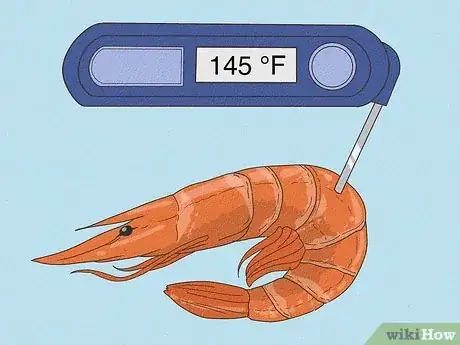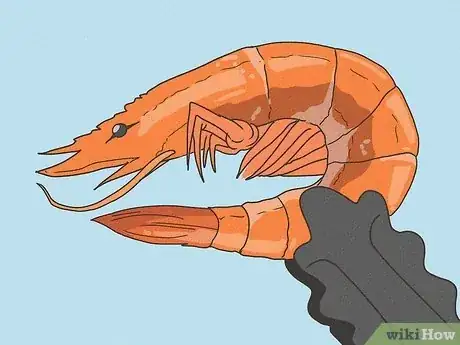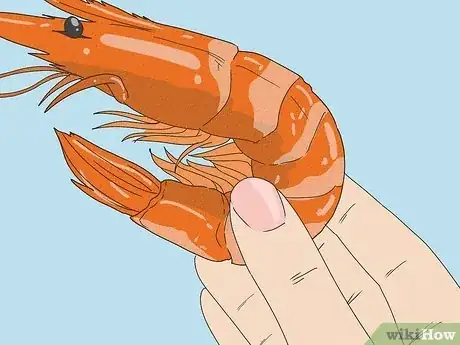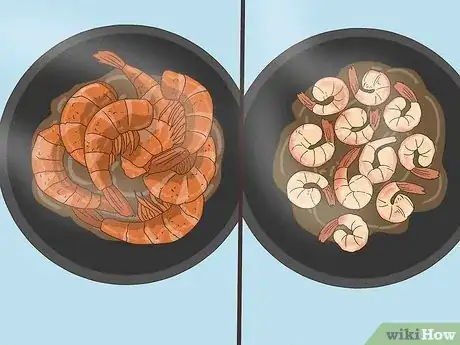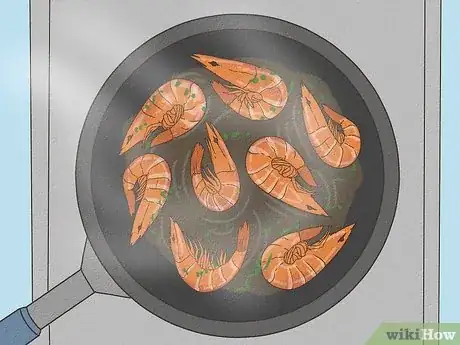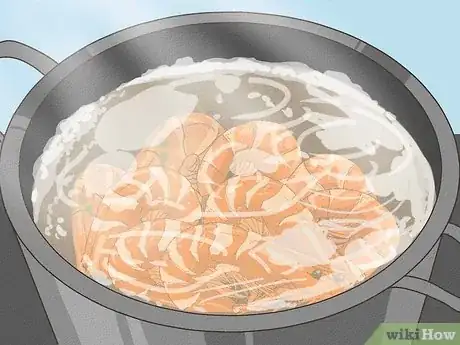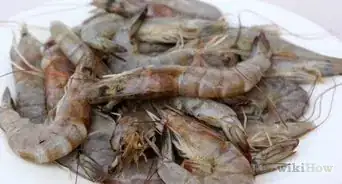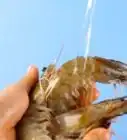This article was co-authored by Ririka Evans and by wikiHow staff writer, Dan Hickey. Ririka Evans is a Personal Chef and the Founder of Home Cooking Solutions based in Frederick, Maryland. She has been a Chef for over 11 years at commercial kitchens across Japan and the US. She specializes in Japanese food and home-cooked meals. She creates customized menus and cooks for both families and special events. She’s prepared meals for clients from all walks of life, including public figures, CEOs, business owners, professionals, and busy families. She studied cooking and catering at Stratford Career Institute and is a certified ServSafe Food Protection Manager.
There are 10 references cited in this article, which can be found at the bottom of the page.
This article has been viewed 20,064 times.
Shrimp is a delicious and nutritious addition to many meals when it’s cooked just right, but how can you tell if it’s cooked through? Shrimp makes a huge transformation in appearance from raw to cooked, so eyeballing it isn’t so hard when you know what to look for—an opaque white and pink color and a curved “C” shape mean it’s time to eat (and if you’re still not sure, check the internal temp and make sure it’s 145 °F (63 °C) or higher). In this article, we’ll walk you through every way to check if your shrimp is done, plus ways you can make sure that every shrimp in your batch finishes at the same time. If you’re ready to get cooking, keep scrolling!
Things You Should Know
- Use a food thermometer to make sure the interior temperature of a shrimp is at least 145 °F (63 °C). This is the safest way to tell if it’s fully cooked.
- Check for an opaque white color on the outside, a curved “C” shape, and a tender texture. When in doubt, cut one open to see if it’s cooked through.
- Ensure all your shrimp finish at the same time by spreading them evenly over a pan or tray and adding them to the heat at the same time.
Steps
Expert Q&A
-
QuestionCan you tell if shrimp is bad by taste?
 Ririka EvansRirika Evans is a Personal Chef and the Founder of Home Cooking Solutions based in Frederick, Maryland. She has been a Chef for over 11 years at commercial kitchens across Japan and the US. She specializes in Japanese food and home-cooked meals. She creates customized menus and cooks for both families and special events. She’s prepared meals for clients from all walks of life, including public figures, CEOs, business owners, professionals, and busy families. She studied cooking and catering at Stratford Career Institute and is a certified ServSafe Food Protection Manager.
Ririka EvansRirika Evans is a Personal Chef and the Founder of Home Cooking Solutions based in Frederick, Maryland. She has been a Chef for over 11 years at commercial kitchens across Japan and the US. She specializes in Japanese food and home-cooked meals. She creates customized menus and cooks for both families and special events. She’s prepared meals for clients from all walks of life, including public figures, CEOs, business owners, professionals, and busy families. She studied cooking and catering at Stratford Career Institute and is a certified ServSafe Food Protection Manager.
Personal Chef Technically, you can, but don't trust taste alone. You can eat it for up to three days, if kept in the refrigerator. After that, I don't recommend it.
Technically, you can, but don't trust taste alone. You can eat it for up to three days, if kept in the refrigerator. After that, I don't recommend it.
Warnings
- Eating raw or undercooked shrimp can result in food poisoning, cholera, gastritis, and other foodborne illnesses. Only the highest-quality sushi-grade shrimp is safe to eat undercooked.[16]⧼thumbs_response⧽
References
- ↑ https://www.fda.gov/food/buy-store-serve-safe-food/selecting-and-serving-fresh-and-frozen-seafood-safely
- ↑ https://extension.umn.edu/preserving-and-preparing/food-thermometers
- ↑ https://simplegrillrecipes.com/how-to-tell-when-grilled-shrimp-is-done/
- ↑ https://simplegrillrecipes.com/how-to-tell-when-grilled-shrimp-is-done/
- ↑ https://simplegrillrecipes.com/how-to-tell-when-grilled-shrimp-is-done/
- ↑ https://whatscookingamerica.net/shrimptips.htm
- ↑ https://www.thekitchn.com/my-favorite-way-to-cook-shrimp-tips-from-the-kitchn-217336
- ↑ https://www.thekitchn.com/how-to-quickly-cook-shrimp-on-the-stovetop-cooking-lessons-from-the-kitchn-214397
- ↑ https://whatscookingamerica.net/shrimptips.htm
- ↑ https://www.macheesmo.com/how-to-steam-shrimp/
- ↑ https://whatscookingamerica.net/shrimptips.htm
- ↑ https://www.thekitchn.com/how-to-roast-shrimp-in-the-oven-cooking-lessons-from-the-kitchn-204080
- ↑ https://www.macheesmo.com/how-to-steam-shrimp/
- ↑ https://whatsinthepan.com/how-to-cook-shrimp/
- ↑ https://whatscookingamerica.net/shrimptips.htm
- ↑ https://kitchentablescraps.com/japanese-cuisine/can-you-eat-raw-shrimp-in-sushi/
